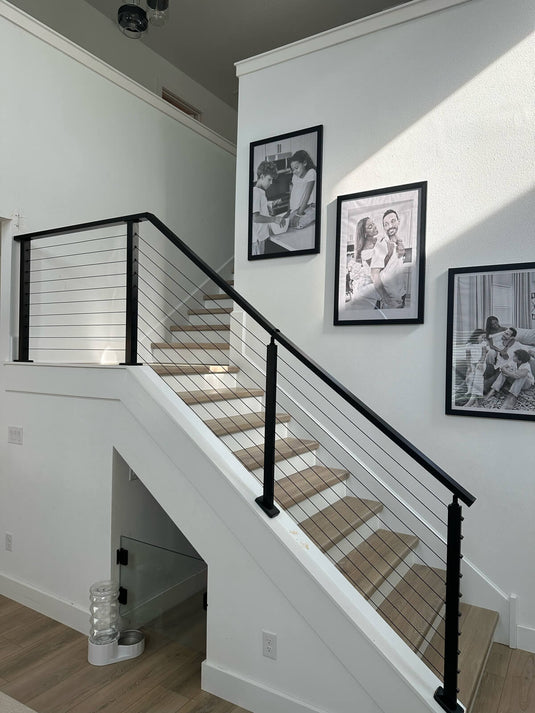TABLE OF CONTENTS
Wood vs Metal: Which Floating Stairs is Better?
Floating stairs are a design choice that marries elegance with functionality in modern homes. As you consider adding this eye-catching feature to your space, you're likely weighing the pros and cons of two common materials: wood and metal. In this article, we'll talk about the various aspects of wooden versus metal floating stairs—with a special focus on the sleek and sturdy floating steel stairs—to help you determine which material best suits your aesthetic preferences, practical needs, and budget. Whether you're seeking the warm, natural appeal of wood or the sleek, industrial sophistication of metal, knowing the nuances of each option will help you make a better choice.
Quick Comparison Sheet
| Aspect | Wooden Floating Stairs | Metal Floating Stairs |
| Durability | Susceptible to scratches, humidity; can expand/contract. | High resilience; resists warping, shrinking, bending over time. |
| Maintenance | Needs periodic resealing/varnishing; more vulnerable to wear and damage. | Requires less maintenance; often just a wipe-down with soapy water. |
| Weather Resistance | Requires extensive treatment for outdoor use. | Typically more durable outdoors with protective coatings. |
| Installation Considerations | Requires extra support, high woodworking skill, and potentially longer installation time. | Typically self-supporting, needs metalwork expertise, and offers quicker prefab assembly. |
| Initial Cost | Varies; can be cost-effective but may increase with design complexity. | Higher initial cost reflecting material quality and specialized labor. |
| Long-Term Value | Additional maintenance costs expected over time. | Lower repair/replacement costs; generally a more secure long-term investment. |
| Customization | Complex designs can be costly with wood. | Metal allows for precision and easier customization in complex designs. |
| Resale Value | Classic appeal may enhance property value. | Modern look and durability can significantly boost property value. |
| Eco-Friendliness | Renewable when sustainably sourced; carbon-storing. | Recyclable; often includes recycled content, but energy-intensive to produce. |
| Ideal For | Traditional homes; DIY enthusiasts; artisanal focused spaces. | Modern spaces; high-traffic/public areas; outdoor environments. |
Wood vs. Metal Floating Stairs: Which Lasts Longer and Is Easier to Maintain?
Standing the Test of Time
Metal floating stairs, particularly those crafted from steel, are renowned for their strength and resilience. Floating steel stairs resist warping, shrinking, and bending over time, attributes that assure homeowners of their lasting structural integrity. Wood, while sturdy, is susceptible to wear, such as scratches, and can be affected by environmental factors like humidity, which can cause expansion or contraction.
Keeping Up Appearances
Maintenance routines differ markedly between wood and metal staircases. Wooden stairs may require resealing or varnishing periodically to maintain their finish and guard against scratches or water damage. Metal stairs, on the other hand, need less frequent attention. A wipe-down with soapy water is often enough to keep metal floating stairs looking new. Furthermore, metal is less likely to suffer from issues related to pests, such as termites, which can be a concern with wood in certain climates.
Weathering the Elements
If your floating staircase will face the elements outdoors, metal is typically the more durable choice. Floating steel stairs are especially resilient when treated with weather-resistant coatings. While outdoor-grade wood can be used for exterior stairs, it usually requires more comprehensive and regular treatment to withstand the weather compared to its metal counterparts.
Wood vs. Metal Floating Stairs: What Should Need to Consider When Installing?
- The Foundation of Installation: Installation begins with ensuring proper structural support, which is intrinsically linked to the material of the staircase. Wood staircases may require additional framework within the walls for support due to their weight. In contrast, metal floating stairs, particularly floating steel stairs, often have a self-supporting design. Their robust nature allows for fewer anchor points, meaning less invasive work is needed to fit them securely in place.
- Precision and Expertise: Installing any floating staircase demands precision. For wooden staircases, this means exact cuts and joints that align perfectly to prevent creaks or movement. With metal floating stairs, precision is equally important; each weld and joint must be executed flawlessly to ensure the structure's integrity. Professional installers with experience in metalwork are typically required for floating steel stairs, given the specialized tools and techniques involved.
- Time Frame and Complexity: The complexity of the staircase design can affect how long the installation takes. Simple straight runs may be quicker to install than more elaborate designs with multiple landings or turns. Generally, metal floating stairs can be prefabricated in sections and assembled on-site, potentially offering a faster installation compared to wood, which might require extensive in-situ carpentry work.
Comparing Costs: Wood vs. Metal Floating Stairs
1. Initial Investment
The upfront cost of installing a staircase will vary depending on material choice and design complexity. Wooden staircases might seem more cost-effective initially; however, exotic woods or intricate designs can inflate prices significantly. Conversely, metal floating stairs tend to have a higher initial price point, especially for floating steel stairs, which reflects the cost of materials and specialized labor for installation.
2. Long-Term Value
Looking at the long-term perspective, metal floating stairs often provide a more secure investment. The durability and low maintenance requirements of floating steel stairs mean fewer repair or replacement costs down the line. Wood staircases, while potentially cheaper at the outset, may incur additional expenses over time through maintenance, repairs, or refinishing.
3. Customization and Complexity
Custom designs can drive up costs in both materials. However, steel offers a degree of precision and customization that wood does not always match without significant extra expense. Metal fabrication processes make intricate patterns and unique configurations more readily achievable, making floating steel stairs a preferred option for bespoke design solutions.
4. Resale Value Enhancement
Investing in high-quality floating stairs can also enhance the value of your property. Metal floating stairs, thanks to their modern appeal and lasting quality, can be a selling point if you decide to put your home on the market. They make a striking feature that stands out in real estate listings, potentially providing a higher return on investment compared to wood.

Wood vs. Metal Floating Stairs: Which Are More Eco-Friendly
Wood Floating Stairs:
Wood is often praised for its natural origin, which carries the perception of being eco-friendly. When sourced responsibly from sustainably managed forests, wood can be a renewable resource with a smaller carbon footprint than metal. Trees absorb carbon dioxide as they grow, which means that wood products can store carbon throughout their lifecycle.
However, the environmental friendliness of wood staircases also depends on the type of wood and the distance it travels from its source to your home. Locally sourced wood has a lower transportation impact compared to exotic woods that need to be shipped from faraway forests. Additionally, the treatment and finishing of wood stairs require careful consideration; some processes and chemicals used for preservation, staining, or sealing might release volatile organic compounds (VOCs) into the environment.
Metal Floating Stairs:
Metal, particularly steel, is highly durable and typically has a longer lifespan than wood, which can make it an environmentally sound choice over time. Steel often includes a significant amount of recycled content, which reduces the need for virgin materials and the environmental degradation associated with mining. Moreover, at the end of its life, metal is fully recyclable, ensuring that the material can be reused in new products without losing its properties.
The production of metal, however, is energy-intensive, leading to higher initial greenhouse gas emissions. This is especially true for primary steel production from iron ore. Despite this, advancements in metallurgy and manufacturing have steadily reduced energy consumption and improved the efficiency of metal production. The application of protective coatings can extend the life of metal stairs, minimizing the frequency of replacements or repairs.
Wood vs. Metal Floating Stairs: Who They Suit Best
Wooden Floating Stairs
- Traditional and Classic Home Fans: Perfect for those who love classic home styles and want an inviting atmosphere.
- Environmentally Conscious People: Ideal for individuals dedicated to sustainability and eco-friendly materials.
- Artisan Appreciators: Great for those who value the beauty of craftsmanship and custom woodwork.
- Residential Use: Suitable for homes needing quiet, comfort, and a touch of elegance.
- Home DIYers: Wood stairs are user-friendly for repairs and personal projects.
Metal Floating Stairs
- Modern Style Enthusiasts: A match for lovers of sleek, contemporary design.
- Seekers of Durability: Optimal for those wanting stairs that last with minimal care.
- Busy Venues: Perfect for commercial spaces or areas with regular foot traffic.
- Outdoor Settings: Ideal for outside use due to strong resistance to weather.
- Safety Prioritizers: Good for places where safety features and durability are key.

Making the Material Match Your Needs
Choosing the right material for your floating stairs matches your home's style with practical considerations such as durability, safety, and cost. Wood offers classic beauty and warmth but may require more upkeep and could have a larger environmental footprint if not sourced sustainably. Metal, particularly steel, provides modern appeal, requires less maintenance, and often lasts longer, potentially providing greater value over time. Ultimately, your choice should reflect both your current taste and anticipated needs, ensuring that your staircase is a reliable and sustainable element in your home.




